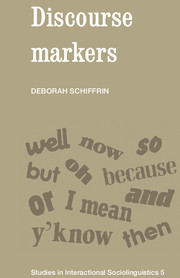Book contents
- Frontmatter
- Contents
- Acknowledgements
- Intonation and transcription conventions
- 1 Background: What is discourse?
- 2 Prelude to analysis: Definitions and data
- 3 Questions: Why analyze discourse markers?
- 4 Oh: Marker of information management
- 5 Well: Marker of response
- 6 Discourse connectives: and, but, or
- 7 So and because: Markers of cause and result
- 8 Temporal adverbs: now and then
- 9 Information and participation: y'know and I mean
- 10 Discourse markers: Contextual coordinates of talk
- Notes
- References
- Author index
- Subject index
7 - So and because: Markers of cause and result
Published online by Cambridge University Press: 05 June 2012
- Frontmatter
- Contents
- Acknowledgements
- Intonation and transcription conventions
- 1 Background: What is discourse?
- 2 Prelude to analysis: Definitions and data
- 3 Questions: Why analyze discourse markers?
- 4 Oh: Marker of information management
- 5 Well: Marker of response
- 6 Discourse connectives: and, but, or
- 7 So and because: Markers of cause and result
- 8 Temporal adverbs: now and then
- 9 Information and participation: y'know and I mean
- 10 Discourse markers: Contextual coordinates of talk
- Notes
- References
- Author index
- Subject index
Summary
I consider so and because together because they are complements both structurally (7.1) and semantically (7.2). Like and, but and or, so and because have grammatical properties which contribute to their discourse use. When so and because mark idea units, information states, and actions, their functions are straightforward realizations of these properties. But when so has a pragmatic use in participation structures, its grammatical properties are less directly realized (7.3).
Structure: main and subordinate units
So and because are grammatical signals of main and subordinate clauses respectively, and this grammatical difference is reflected in their discourse use: because is a marker of subordinate idea units, and so is a complementary marker of main idea units. Before I show this, however, it is important to define ‘subordinate’ and ‘main’ in discourse. Such designations depend on both the functional and referential organization of talk. From a functional perspective, subordinate material is that which has a secondary role in relation to a more encompassing focus of joint attention and activity. From a referential perspective, subordinate material is that which is not as relevant in and of itself, as it is to a more global topic of talk. I also assume that material which is functionally and/or referentially dependent is likely to be structurally dependent on a larger textual unit of talk, and thus, subordinate in this sense.
- Type
- Chapter
- Information
- Discourse Markers , pp. 191 - 227Publisher: Cambridge University PressPrint publication year: 1987



